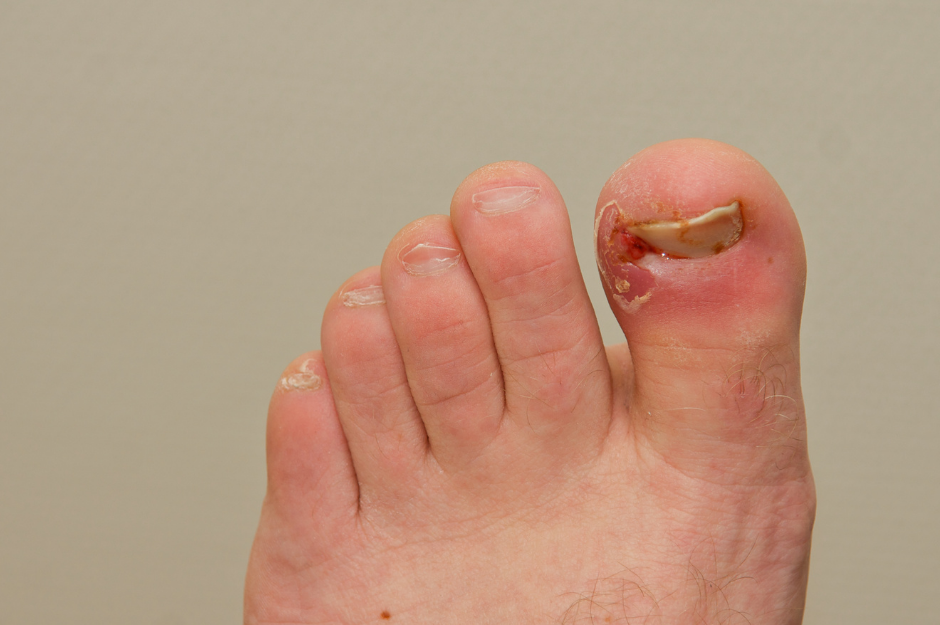
- Will antibiotics fix an ingrown toenail?
- If I’ve had an ingrown nail removed, should I have antibiotics?
These are all good questions, and ones we get asked often by our patients with painful – and often recurring – ingrown toenails. Today our podiatrists share what you should know about ingrown toenails and antibiotics.
Will Antibiotics Fix An Ingrown Toenail?
No, antibiotics are not going to fix an ingrown toenail because they are not a treatment for ingrown toenails. Antibiotics describes a medicine that helps destroy microorganisms like bacteria that have caused an infection in the body, and hence are doing harm. An ingrown toenail on its own is not an ‘infection’ – it’s a piece of nail that has pierced the skin surrounding it at the toe, and has become painful, and often red and swollen. This pain and other symptoms will continue as long as the nail remains embedded in or penetrating the skin – and antibiotics do not work to remove this or fix it.
What antibiotics can do is, if an infection has developed in the area of the ingrown nail, then the antibiotics can help resolve the infection. As infections also lead to swelling and pain, this can help with settling the symptoms and giving some much needed relief. What’s important to know is that just because you have an ingrown nail, does not mean that you have an infection too. Antibiotics should be reserved for confirmed infections, not on a whim or ‘just in case’, as frequent and inappropriate use of antibiotics can lead to the bacteria becoming resistant to the antibiotics, and so not working as effectively when you actually do need them. You should only take antibiotics when and if prescribed by your doctor, always finish the full course, and if you have any tablets remaining, discard them.
If I’ve Had An Ingrown Nail Removed, Should I Have Antibiotics?
Similar to the above, no, you do not need antibiotics simply from having an ingrown toenail removed, unless you have an infection that requires antibiotics. Signs you have an infected ingrown toenail include:
- Clear or yellow discharge coming from the side of the nail
- Bleeding from the side of the nail
- Swollen, overgrown or inflamed tissue around the edge of the toenail
- If an abscess develops, you’ll notice a yellow/white fluid-filled pocket
- Redness around the side of the nail
Remember – you may also have some redness and swelling simply from the nail piercing the skin, without having an infection present.
When our podiatrists treat ingrown toenails, we do everything we can to help minimise your risk of infection. When performing ingrown nail surgery, we prepare your toe and foot by applying an iodine solution, use only sterilised instruments, and apply incredibly high safety and hygiene protocols, dressing your toe with multiple sterile dressings and a protective cover after removing your ingrown nail. We always provide careful redressing instructions and foot care advice, including a take-home dressing pack, so you can continue to take good care of your foot at home. At your follow up appointment 2-3 days after your procedure, we always monitor for any signs of infection and advise you if we think you may need antibiotics.
In some cases, your doctor may recommend antibiotics as a preventative measure due to an existing condition you have, including if you are particularly vulnerable to infections. Always follow your doctor’s advice and take any prescribed medications as directed.
If My Ingrown Nail Is Infected, Do I Need To Clear The Infection Before Treatment?
This really depends on the severity of your infection and your personal circumstances, and our podiatrists will assess this at the time of your appointment. A big part of treating an ingrown toenail and helping prevent re-infection is getting the ingrown nail out so the wound that it has created can close – and therefore not be vulnerable to another infection.
Here at the Auckland Ingrown Toenail Clinic in Remuera, we treat ingrown nails in one of three ways:
- Conservative nail care – for first time ingrown toenails, we remove the offending nail spicule if it doesn’t look like the nail will re-grow back and keep causing you pain
- Partial nail avulsion – for recurring ingrown toenails, we remove the nail spicule permanently, using a chemical to prevent the problematic edge of the nail from growing back in the future
- Total nail avulsion – for recurring ingrown toenails that have a secondary problem, like a thickened, damaged or distorted nail – or one with a fungal infection too – we can perform a total nail avulsion. This involves removing the entire nail and allowing it to grow back naturally hopefully without the previous issues
Get Your Ingrown Nail Fixed Quickly And Painlessly
If you need help with a problematic ingrown toenail, our is here to help, located in the One Health building in Remuera. Book your appointment by calling 09 523 2333 or book online

